This article provides a step-by-step guide to pinning a boutonniere efficiently, ensuring a polished look for any formal occasion. A boutonniere is not merely a floral accessory; it represents sophistication and attention to detail, enhancing your overall appearance for events such as weddings, proms, and formal gatherings. Mastering the art of pinning a boutonniere can elevate your style and confidence.
Understanding the Importance of a Boutonniere
A boutonniere serves as a small yet significant statement piece. It symbolizes elegance, personal style, and sometimes, a connection to the event’s theme. Wearing a boutonniere can reflect your personality and attention to detail, making it a crucial element for any formal attire. Understanding its importance can enhance your experience and appreciation for this accessory.
Choosing the Right Flower for Your Boutonniere
Selecting the perfect flower is essential, as different flowers convey various meanings and aesthetics. Here are some popular choices:
- Roses: A classic choice symbolizing love and passion.
- Orchids: Representing beauty and strength, ideal for a sophisticated look.
- Lilies: Symbolizing purity and refined beauty, perfect for formal occasions.
Seasonal Considerations
Choosing flowers that are in season not only affects availability but also impacts cost. Seasonal flowers are often fresher and more vibrant, making them a better choice for your boutonniere.
Preparing the Boutonniere for Pinning
Proper preparation ensures that the boutonniere looks its best and stays secure throughout the event. Here’s how to get it ready:
- Trimming the Stem: A clean, angled cut allows for better water absorption and a polished appearance.
- Using Floral Tape: Wrap the stem with floral tape to secure the flower and prevent any damage during pinning.
Tools You Need for Pinning
Having the right tools on hand can streamline the pinning process. Essential tools include:
- Choosing the Right Pin: A sturdy, sharp pin ensures the boutonniere stays in place without damaging your clothing.
- Using a Safety Pin: Safety pins provide extra security, especially for heavier flowers or outdoor events.
Step-by-Step Guide to Pinning a Boutonniere
This step-by-step guide simplifies the process, making it easy to pin your boutonniere in under 60 seconds:
- Positioning the Boutonniere: Place it on the left lapel, ideally above the heart for a balanced look.
- Pinning Technique: Insert the pin from behind the lapel, through the stem of the flower, and back out through the fabric for a secure hold.
Common Mistakes to Avoid
Understanding common pitfalls can help ensure a flawless boutonniere presentation:
- Poor Placement: Avoid placing the boutonniere too low or too high, which can detract from its visual appeal.
- Neglecting to Secure Properly: Failing to pin securely can lead to the boutonniere falling off or shifting during wear.
Maintaining Your Boutonniere Throughout the Event
To keep your boutonniere looking fresh, consider these tips:
- Staying Hydrated: Keep the boutonniere in water until just before the event to preserve its freshness.
- Avoiding Heat and Direct Sunlight: This helps maintain its appearance for the duration of the event.
Removing the Boutonniere Gracefully
Knowing how to remove the boutonniere without damage is just as important as pinning it:
- Careful Removal Techniques: Use gentle pressure to remove the pin, ensuring not to damage your clothing.
- Storing the Boutonniere: If you wish to keep it, store it in a cool place to preserve its beauty for a longer time.
With practice and attention to detail, anyone can master the art of pinning a boutonniere in under 60 seconds, resulting in a polished and elegant look for any occasion.
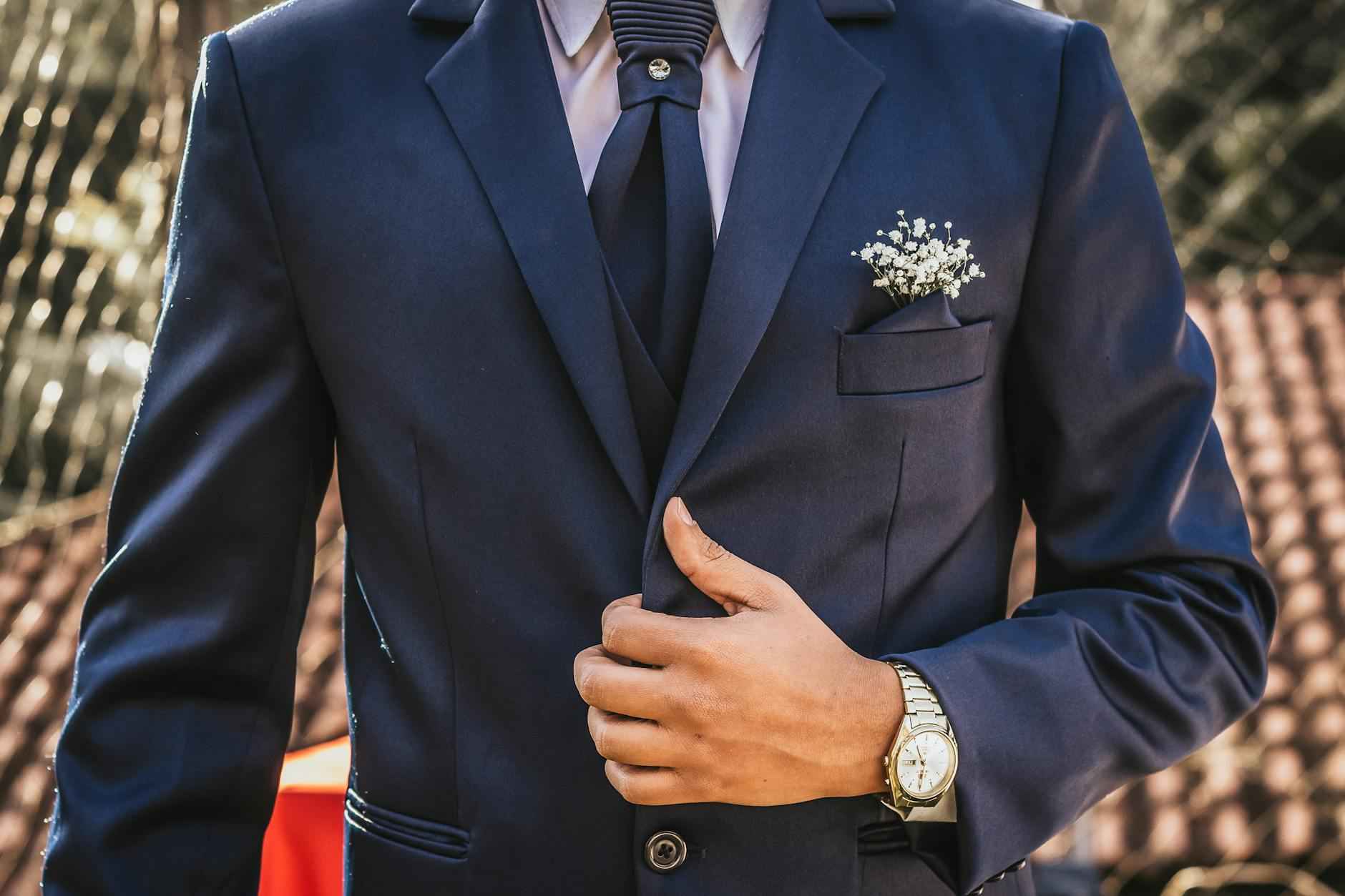
Understanding the Importance of a Boutonniere
A boutonniere is not merely a decorative flower; it is a symbol of elegance and sophistication. Traditionally worn by men, this small accessory serves as a focal point that can enhance any formal outfit, from tuxedos to suits. Understanding the importance of a boutonniere can significantly enhance your appreciation for this timeless accessory, allowing you to embrace its significance in various social contexts.
Historically, the boutonniere has roots tracing back to the medieval period, where knights wore flowers in their armor as tokens of love or to signify allegiance to a lady. Today, it has evolved into a fashion statement that represents style, class, and individuality. Whether at weddings, proms, or formal gatherings, the boutonniere plays a pivotal role in completing the overall look.
Each flower chosen for a boutonniere carries its own meaning, adding layers of significance to the accessory. For instance, a red rose symbolizes love and passion, while a white rose signifies purity and innocence. Understanding these meanings can help you select a flower that resonates with the event’s sentiment.
- Red Roses: Love and passion
- White Roses: Purity and innocence
- Orchids: Exotic beauty and strength
- Lilies: Purity and refined beauty
When selecting a boutonniere, consider not only the aesthetic but also the message you wish to convey. This thoughtful approach can elevate your style and express your personality.
The boutonniere is a unique way to express personal style. In a world where fashion often leans towards the conventional, a well-chosen boutonniere can set you apart. It allows for creativity, enabling you to mix colors and textures that complement your attire. Additionally, it provides an opportunity to incorporate seasonal flowers or themed elements, making your look even more personalized.
For example, during spring or summer weddings, vibrant flowers such as daisies or peonies can add a cheerful touch, while autumn events may call for deeper hues like burgundy or gold. This adaptability makes the boutonniere a versatile accessory suitable for various occasions.
A boutonniere adds a finishing touch to formal wear, enhancing the overall appearance. It draws attention to the lapel, creating a polished look that exudes confidence. When pinned correctly, it not only stays secure but also complements the suit or tuxedo, enhancing the wearer’s stature.
| Event Type | Recommended Flower | Meaning |
|---|---|---|
| Wedding | Roses | Love and romance |
| Prom | Orchids | Elegance and beauty |
| Funeral | Lilies | Purity and remembrance |
| Graduation | Daisies | New beginnings |
In conclusion, the boutonniere is much more than a simple flower; it embodies tradition, symbolism, and style. By understanding its importance, you can select the perfect flower that not only enhances your outfit but also conveys your sentiments effectively. Whether you are attending a wedding, a formal event, or a special occasion, the boutonniere is an accessory that can elevate your look and make a lasting impression.
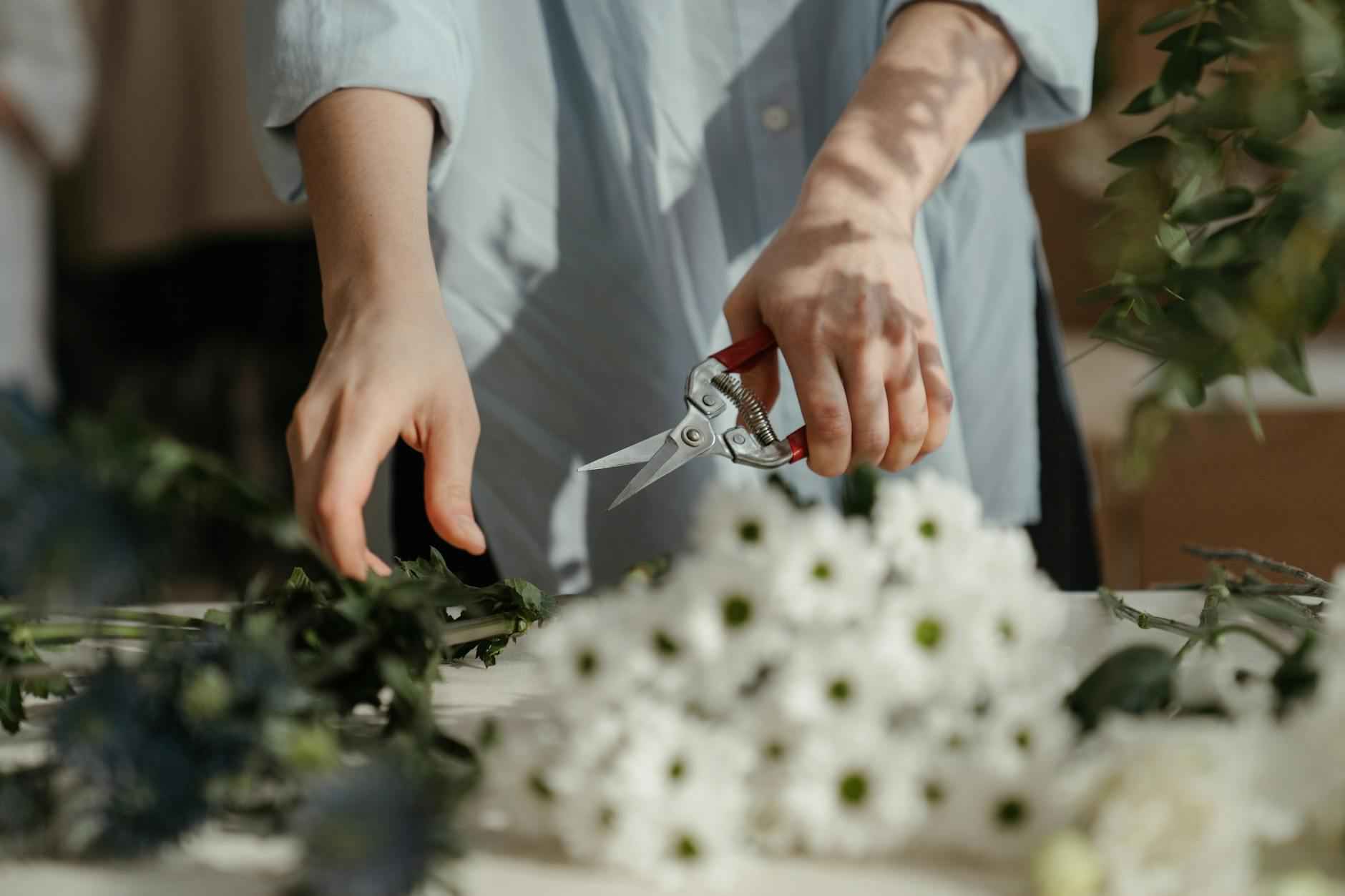
Choosing the Right Flower for Your Boutonniere
When it comes to formal occasions, a boutonniere is an essential accessory that adds a touch of elegance and personal style. However, the choice of flower is not merely a matter of aesthetics; it also carries significant meaning and symbolism. This section delves into the importance of selecting the right flower for your boutonniere, exploring popular options and their associated meanings.
Choosing the right flower for your boutonniere is crucial because flowers convey different emotions and messages. Each flower has its own unique significance, and understanding this can enhance the overall impact of your look. Here are some popular choices:
- Roses: Often considered the quintessential flower, roses symbolize love and passion. Their classic beauty makes them a timeless choice for any formal event.
- Orchids: Known for their exotic appearance, orchids represent beauty and strength. They are often chosen for their elegance and unique characteristics.
- Lilies: Lilies symbolize purity and refined beauty. They are versatile and can add a touch of sophistication to your ensemble.
- Sunflowers: Representing adoration and loyalty, sunflowers are perfect for a cheerful and vibrant look. They can brighten up any outfit.
- Carnations: These flowers symbolize a love that is eternal and are often used in weddings. Their ruffled petals add a romantic touch to any boutonniere.
Each flower carries a unique meaning, which can influence your choice based on the event and your personal sentiments. For instance:
| Flower | Meaning |
|---|---|
| Roses | Love and Passion |
| Orchids | Beauty and Strength |
| Lilies | Purity and Refined Beauty |
| Sunflowers | Adoration and Loyalty |
| Carnations | Everlasting Love |
Understanding these meanings can help you select a flower that resonates with the occasion and your feelings. For example, if you are attending a wedding, a rose or a lily might be more appropriate, while a sunflower could be ideal for a casual summer event.
Another important factor to consider is the seasonality of flowers. Some flowers are only available during certain times of the year, which can affect both availability and cost. Here’s a quick guide:
- Spring: Tulips, daffodils, and peonies are in season.
- Summer: Sunflowers, dahlias, and roses flourish.
- Fall: Mums, asters, and marigolds are popular choices.
- Winter: Poinsettias and evergreens are often used in arrangements.
Choosing flowers that are in season can not only save you money but also ensure that your boutonniere looks fresh and vibrant.
Beyond the basic meanings and seasonal considerations, personalizing your boutonniere can make it even more special. Consider incorporating:
- Favorite Colors: Choose flowers that match the color scheme of your outfit or event.
- Personal Symbols: Incorporate flowers that have personal significance to you or the occasion.
- Textures: Mix different types of flowers and foliage to create a unique look.
By taking the time to choose the right flower for your boutonniere, you can enhance your overall appearance and convey a meaningful message, making your formal occasion even more memorable.
Popular Flower Options
When it comes to selecting the perfect flower for a boutonniere, the choices are abundant and diverse. Each flower not only brings its unique aesthetic but also conveys specific meanings and emotions. Understanding these options can significantly enhance your overall look and the message you wish to communicate on your special day. Below, we explore some of the most popular flower options for boutonnieres, including their characteristics and significance.
- Roses
- Orchids
- Lilies
- Carnations
- Sunflowers
- Freesias
Each of these flowers has its own unique charm and can enhance your overall look in different ways. Let’s take a closer look at some of these popular choices:
Roses are perhaps the most classic choice for a boutonniere. Known for their timeless beauty, roses symbolize love and passion. They come in a variety of colors, each representing different emotions:
| Color | Meaning |
|---|---|
| Red | Love and Romance |
| White | Purity and Innocence |
| Pink | Admiration and Gratitude |
| Yellow | Friendship and Joy |
Roses can be used alone or mixed with other flowers, making them a versatile option for any formal occasion.
Orchids are another popular choice, known for their exotic appearance and elegance. They symbolize beauty, strength, and luxury. Their unique shapes and colors can add a touch of sophistication to your look. Orchids are also long-lasting, which ensures that your boutonniere will remain fresh throughout the event.
Lilies are often associated with purity and refined beauty. With their striking blooms and delightful fragrance, they can make a bold statement. Available in various colors, including white, orange, and pink, lilies can be tailored to match your outfit or the theme of the event. They are particularly popular for weddings and formal gatherings.
Carnations are a cost-effective option that offers a wide range of colors and sizes. They are known for their ruffled petals and long-lasting nature. Symbolizing a love that is eternal, carnations are perfect for formal events and can be easily combined with other flowers for a more textured look.
For a more vibrant and cheerful option, sunflowers can be an excellent choice. They symbolize adoration and loyalty, and their bright yellow petals can add a pop of color to your attire. Sunflowers work particularly well for outdoor events and can bring a sense of warmth and joy to the occasion.
Freesias are known for their sweet fragrance and delicate appearance. They symbolize friendship and trust, making them a heartfelt choice for events where emotional connections are celebrated. Freesias can be used alone or mixed with other flowers to create a lovely bouquet.
In conclusion, each flower option for a boutonniere offers its own unique characteristics and meanings. By understanding these attributes, you can choose a flower that not only complements your outfit but also conveys the right message for your special occasion. Whether you opt for the classic elegance of roses, the exotic allure of orchids, or the cheerful brightness of sunflowers, the right boutonniere can enhance your overall look and make a lasting impression.
Roses
have long been celebrated as one of the most iconic flowers in the world, symbolizing love, passion, and beauty. Their rich history and diverse range of colors make them a versatile choice for various occasions. Whether it’s a wedding, anniversary, or a simple gesture of affection, roses hold a special place in the hearts of many. In this section, we will explore the significance of roses, their various meanings based on color, and how they can enhance the aesthetics of any event.
Roses have been associated with love for centuries, tracing back to ancient civilizations. The Greeks and Romans revered these flowers, linking them to their goddesses of love, Aphrodite and Venus, respectively. This longstanding association has cemented roses as a universal symbol of romance. Their exquisite beauty and captivating fragrance evoke feelings of desire and affection, making them a timeless choice for expressing deep emotions.
The color of a rose can convey different sentiments, adding layers of meaning to the gesture. Below is a table summarizing the significance of various rose colors:
| Rose Color | Meaning |
|---|---|
| Red | Love and Passion |
| White | Purity and Innocence |
| Yellow | Friendship and Joy |
| Pink | Admiration and Gratitude |
| Orange | Desire and Enthusiasm |
| Lavender | Love at First Sight |
Understanding these meanings allows individuals to choose the right rose color for their intended message, enhancing the emotional impact of the gift.
Roses are a popular choice for various events, each with its unique significance:
- Weddings: White roses symbolize purity and new beginnings, making them a favorite for bridal bouquets.
- Anniversaries: Red roses are often gifted to signify enduring love and passion.
- Valentine’s Day: On this day dedicated to love, red roses reign supreme, expressing heartfelt emotions.
- Funerals: While it may seem counterintuitive, roses can also be used in funeral arrangements, particularly white roses, symbolizing purity and reverence.
To keep roses looking fresh and vibrant, proper care is essential. Here are some tips:
1. Trim the stems at an angle to allow better water absorption.2. Remove any leaves that will be submerged in water to prevent rot.3. Use a clean vase with fresh water and consider adding flower food.4. Change the water every few days to maintain freshness.5. Keep roses away from direct sunlight and heat sources.
Beyond traditional bouquets, there are numerous creative ways to incorporate roses into your event:
- Table Centerpieces: Use roses in arrangements to add elegance to dining tables.
- Decorative Garlands: String roses together to create beautiful garlands for archways or tables.
- Rose Petals: Scatter rose petals along tables or use them in aisle decorations for weddings.
- Rose-Themed Favors: Gift guests with rose-scented candles or soaps as a memorable takeaway.
In summary, roses are a classic choice that embodies love and passion, making them suitable for any occasion. Their diverse meanings, stunning appearance, and versatility allow for creative expression in floral arrangements, ensuring that they remain a beloved choice for generations to come.
Orchids
Orchids are among the most fascinating and diverse flowers on the planet. With over 25,000 species and countless hybrids, they are celebrated not only for their stunning beauty but also for the deeper meanings they carry. In this section, we will explore the significance, varieties, and care of orchids, emphasizing their role in floral arrangements and personal expressions.
Orchids are often chosen for their exotic appearance and elegance. They symbolize not only beauty but also strength and resilience, making them a perfect choice for various occasions, from weddings to corporate events. Their unique shapes and vibrant colors can serve as a stunning focal point in any arrangement.
Orchids have rich symbolism across different cultures. In general, they represent:
- Love and Beauty: Orchids are often associated with love and beauty, making them a popular gift for romantic occasions.
- Strength: The resilience of orchids in various environments symbolizes strength and determination.
- Luxury: Due to their exotic nature and unique forms, orchids are often seen as a luxury flower, representing wealth and sophistication.
When selecting orchids, it’s essential to know the popular varieties and their characteristics. Here are some of the most sought-after types:
| Variety | Description | Ideal Occasions |
|---|---|---|
| Cattleya | Known for their large, fragrant blooms, Cattleyas are often used in corsages and bouquets. | Weddings, Anniversaries |
| Phalaenopsis | Also known as the moth orchid, they are popular for their long-lasting flowers and ease of care. | Home Decor, Gifts |
| Dendrobium | These orchids have a more delicate appearance and come in various colors, making them versatile. | Formal Events, Celebrations |
To keep orchids thriving, proper care is essential. Here are some tips:
- Watering: Orchids prefer to be watered once a week. Ensure that the potting medium dries out slightly between waterings.
- Light: Most orchids thrive in bright, indirect sunlight. Direct sunlight can scorch their leaves.
- Humidity: Orchids enjoy humidity levels of 40-70%. A humidity tray or regular misting can help maintain this environment.
Whether you are planning an event or simply want to enhance your home decor, orchids can add a touch of sophistication. Here are some ideas:
- Weddings: Use orchids in bouquets, centerpieces, and decorations to create an elegant atmosphere.
- Gifts: An orchid plant makes a lasting gift, symbolizing love and appreciation.
- Home Decor: Display orchids in stylish pots to elevate your living space.
In conclusion, orchids are not just beautiful flowers; they carry significant meanings and can enhance any occasion. Their exotic appeal and diverse varieties make them a favorite among flower enthusiasts. By understanding their symbolism and care requirements, you can appreciate these stunning blooms even more.
Seasonal Considerations
When it comes to crafting the perfect boutonniere, one of the most significant aspects to consider is the selection of flowers, particularly their seasonal availability. Choosing flowers that are in season can greatly influence not only the availability but also the cost, making it an essential factor in your selection process.
Seasonal flowers are those that bloom naturally during a particular time of the year. By opting for these flowers, you can enjoy several benefits:
- Cost-Effectiveness: Seasonal flowers are often more affordable as they are abundant and do not require transportation from distant locations.
- Freshness: Flowers that are in season are typically fresher, which means they will last longer and look better throughout your event.
- Environmental Impact: Choosing local, seasonal blooms reduces carbon footprints associated with shipping and storage.
To make informed choices, it’s crucial to understand the blooming cycles of popular flowers. Here’s a breakdown of some common flowers and their peak seasons:
| Flower | Season |
|---|---|
| Roses | Spring and Summer |
| Orchids | Winter and Spring |
| Lilies | Summer |
| Dahlias | Summer and Fall |
| Sunflowers | Summer and Fall |
When selecting flowers for your boutonniere, consider the following tips:
- Research Local Flower Shops: Visit local florists who specialize in seasonal arrangements. They can provide insights into what is currently available.
- Consult with a Florist: A knowledgeable florist can guide you toward flowers that not only fit your aesthetic but are also in season.
- Consider Color Schemes: Seasonal flowers come in various colors. Choose blooms that complement the overall theme of your event.
Utilizing seasonal flowers can also inspire unique arrangements. Here are some ideas:
- Spring: Combine tulips and daffodils for a fresh, vibrant look.
- Summer: Mix sunflowers with wildflowers for a rustic, cheerful vibe.
- Fall: Use dahlias and chrysanthemums for rich, warm tones.
- Winter: Pair orchids with evergreen foliage for an elegant, festive touch.
In summary, choosing seasonal flowers for your boutonniere not only enhances its aesthetic appeal but also ensures freshness and cost-effectiveness. By understanding the seasonal availability of various flowers and consulting with local florists, you can create a beautiful and meaningful accessory that elevates your overall look for any special occasion.
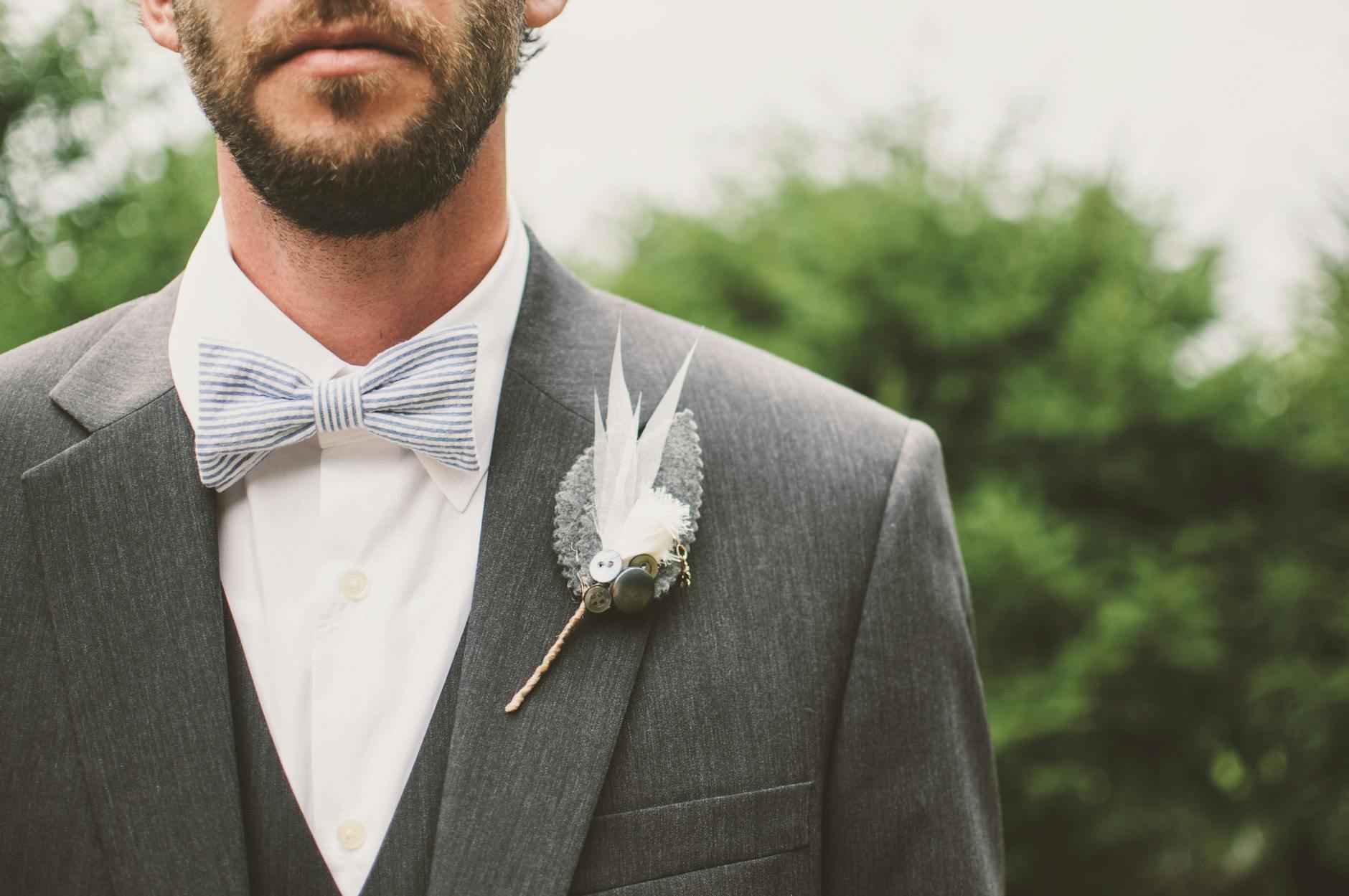
Preparing the Boutonniere for Pinning
Proper preparation of a boutonniere is essential to ensure that it not only looks its best but also remains securely attached throughout your event. Whether you’re attending a wedding, a formal gathering, or any special occasion, taking the time to prepare your boutonniere correctly can make a significant difference in your overall appearance. Here’s a detailed guide to getting your boutonniere ready for pinning.
Understanding the Components of a Boutonniere
A boutonniere typically consists of a single flower or a small cluster of flowers, complemented by greenery or decorative accents. Each element plays a crucial role in the overall aesthetic and should be carefully considered during preparation.
Step 1: Selecting the Right Flower
- Freshness is Key: Choose a flower that is fresh and vibrant, as this will enhance the overall look of your boutonniere.
- Color Coordination: Ensure the flower color complements your outfit and the theme of the event.
- Symbolism: Be mindful of the flower’s meaning; for instance, roses symbolize love, while lilies represent purity.
Step 2: Trimming the Stem
Once you have selected your flower, the next step is trimming the stem. Use sharp scissors or floral shears to make a clean cut:
- Angled Cut: Make an angled cut about 1-2 inches from the base of the flower. This increases the surface area for water absorption.
- Length Consideration: Ensure the stem is long enough to allow for easy pinning, typically around 3-4 inches.
Step 3: Using Floral Tape
To secure the flower and prevent any damage during pinning, wrap the stem with floral tape:
- Wrapping Technique: Start at the base of the flower and wrap downwards, ensuring the tape is tight but not overly constrictive.
- Sealing the Stem: This not only secures the flower but also helps retain moisture, keeping the boutonniere fresh longer.
Step 4: Choosing the Right Pin
Having the right pin is crucial for a successful pinning process:
- Type of Pin: A sharp, sturdy pin will ensure a secure hold without damaging your clothing.
- Safety Pins: Consider using a safety pin for added security, especially if the flower is heavy.
Step 5: Positioning the Boutonniere
Before pinning, decide on the optimal location for the boutonniere:
- Left Lapel: Traditionally, the boutonniere is worn on the left lapel, above the heart.
- Placement Height: Aim for a position that is neither too high nor too low, ensuring it is visible and aesthetically pleasing.
Step 6: Pinning Technique
Now that your boutonniere is prepared, it’s time to pin it:
1. Insert the pin from behind the lapel.2. Pass it through the stem of the flower.3. Bring it back out through the fabric of your clothing.4. Ensure the flower is secure but does not pull on the fabric.
Final Tips for a Perfect Boutonniere
To maintain the integrity and appearance of your boutonniere throughout the event, consider the following:
- Stay Hydrated: Keep the boutonniere in water until just before the event to maintain freshness.
- Avoid Heat: Keep it away from direct sunlight and heat sources to prevent wilting.
By following these steps, you can ensure that your boutonniere is not only beautifully presented but also securely attached, allowing you to enjoy your event without worry. With a little preparation and attention to detail, you can master the art of boutonniere preparation.
Trimming the Stem
When it comes to creating a stunning boutonniere, one of the most crucial steps is the trimming of the stem. This seemingly minor detail can significantly impact the overall presentation and longevity of your floral accessory. A clean, angled cut on the stem not only enhances the absorption of water but also contributes to a more polished and sophisticated appearance. Understanding this process can elevate your boutonniere game, making you stand out at any formal event.
Trimming the stem correctly is essential for several reasons:
- Water Absorption: A fresh cut allows the flower to absorb water more efficiently, which is vital for maintaining its freshness throughout the event.
- Aesthetic Appeal: An angled cut provides a sleek look, enhancing the overall visual presentation of the boutonniere.
- Longevity: Proper trimming can extend the life of the flower, allowing it to look vibrant and fresh for longer periods.
Before you begin the trimming process, ensure you have the right tools on hand:
- Sharp Scissors or Floral Cutters: A clean, sharp cutting tool is essential to avoid crushing the stem and damaging the flower.
- Floral Water: Keeping the stem submerged in water immediately after cutting helps maintain hydration.
- Floral Tape: While not necessary for the trimming process, it will be useful for securing the boutonniere once it is prepared.
Here’s a simple yet effective method to trim the stem of your chosen flower:
- Select Your Flower: Choose a flower that resonates with the occasion and your personal style.
- Prepare Your Tools: Gather your scissors or floral cutters and ensure they are clean and sharp.
- Measure the Desired Length: Hold the flower against your lapel to determine how long you want the stem to be. Typically, a length of 3 to 4 inches is ideal.
- Make the Cut: Using your scissors, cut the stem at a 45-degree angle. This angle increases the surface area for water absorption.
- Submerge the Stem: Immediately place the freshly cut stem into a container of water to keep it hydrated until you are ready to pin the boutonniere.
Even simple tasks like trimming can go awry if you’re not careful. Here are some common mistakes to avoid:
- Using Dull Tools: Dull scissors can crush the stem, hindering water uptake and damaging the flower.
- Cutting Too Short: A stem that is too short may not secure the flower adequately, making it prone to falling off.
- Neglecting to Hydrate: Failing to place the cut stem in water immediately can lead to wilting.
After trimming the stem, it’s crucial to maintain the boutonniere’s freshness:
- Keep it Cool: Store the boutonniere in a cool, shaded area until it’s time to wear it.
- Avoid Direct Sunlight: Exposure to sunlight can cause the flowers to wilt quickly.
- Re-cut Before Pinning: If the boutonniere has been sitting for a while, consider making another angled cut just before pinning to ensure maximum water absorption.
In summary, the art of trimming the stem for a boutonniere is both a science and a craft. By understanding its significance and following the right techniques, you can create a beautiful and long-lasting floral accessory that enhances your overall look for any special occasion.
Using Floral Tape
is an essential step in preparing a boutonniere, ensuring that the flower remains secure and intact throughout the event. This article delves into the significance of floral tape, its application, and tips for optimal usage.
Floral tape is a specialized adhesive tape designed for use in floral arrangements. It is typically made from a stretchy, wax-coated paper that allows it to conform to the shape of the stems and provide a secure grip. The importance of using floral tape extends beyond mere aesthetics; it plays a crucial role in:
- Stabilizing the Flower: Floral tape helps keep the flower in place, preventing it from shifting or falling off during wear.
- Protecting the Stem: The tape acts as a barrier, reducing the risk of damage to the delicate stems when pinning the boutonniere.
- Enhancing Longevity: By wrapping the stem, floral tape can help retain moisture, keeping the flower fresher for longer.
Applying floral tape correctly is key to achieving a polished look. Here’s a step-by-step guide:
- Gather Your Materials: Before you start, ensure you have your flower, floral tape, scissors, and any additional materials you might need.
- Trim the Stem: Begin by trimming the stem of the flower at an angle. This will help with water absorption and create a more aesthetically pleasing look.
- Start Wrapping: Take the floral tape and stretch it slightly as you wrap it around the stem. Start from the base of the flower and work your way down to the end of the stem. Make sure to cover any exposed parts of the stem to provide stability.
- Secure the End: Once you reach the bottom of the stem, press the end of the tape against the stem to secure it in place. The adhesive quality of the tape will help it stick without needing additional glue.
To maximize the benefits of floral tape, consider the following tips:
- Choose the Right Color: Floral tape comes in various colors. For a boutonniere, green is often preferred as it blends well with the foliage and enhances the overall look.
- Use in Layers: If you are using multiple flowers or greenery, consider wrapping each stem individually before bundling them together. This provides additional stability.
- Keep it Dry: Floral tape is not waterproof, so avoid exposing the boutonniere to excessive moisture before the event.
While using floral tape is straightforward, there are a few common pitfalls to be aware of:
- Not Stretching the Tape: Failing to stretch the tape while wrapping can result in a loose hold, making the boutonniere prone to falling apart.
- Overlapping Excessively: While it’s important to cover the stem, overlapping the tape too much can make it bulky and less aesthetically pleasing.
- Neglecting the Stem Length: Make sure to leave an appropriate length of stem exposed for pinning. Cutting it too short can make it difficult to secure the boutonniere properly.
In conclusion, mastering the use of floral tape is an essential skill for anyone looking to create a beautiful boutonniere. By understanding its importance and following the outlined steps and tips, you can ensure that your boutonniere not only looks great but also remains secure throughout your event. With practice, using floral tape will become a quick and easy part of your boutonniere preparation process.
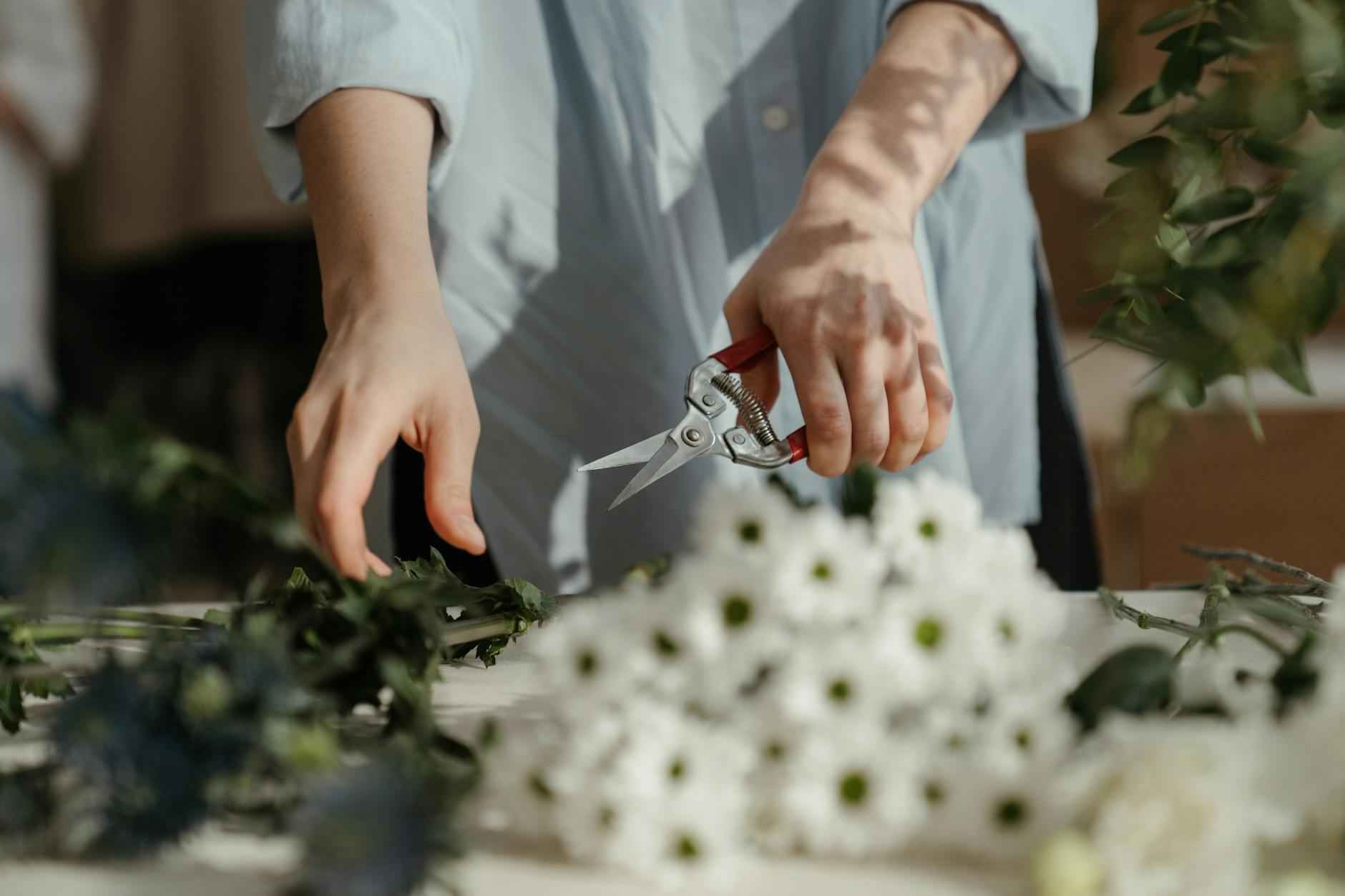
Tools You Need for Pinning
When it comes to pinning a boutonniere, having the right tools is essential for a smooth and efficient process. This section highlights the necessary tools that can help you achieve a perfect pinning experience.
- Quality Pins: The most crucial tool in your arsenal is a quality pin. A sturdy, sharp pin is vital to ensure that the boutonniere stays in place without causing any damage to your clothing. Look for pins that are long enough to secure the flower and penetrate through the fabric effectively.
- Safety Pins: While standard pins are effective, safety pins provide an extra layer of security. They are particularly useful for heavier flowers or during outdoor events where wind might be a factor. Safety pins can help keep the boutonniere firmly attached, preventing any embarrassing mishaps.
- Floral Tape: Before pinning, it’s important to prepare your boutonniere properly. Floral tape can be wrapped around the stem to provide extra support and to keep the flower secure. This prevents any damage during the pinning process and helps maintain the flower’s freshness.
- Scissors or Floral Cutters: A clean cut is essential for the stem of the flower. Using sharp scissors or floral cutters allows for an angled cut, which promotes better water absorption and enhances the overall appearance of the boutonniere.
- Mirror: A small mirror can be incredibly helpful when pinning a boutonniere. It allows you to see the placement from different angles, ensuring that it looks perfect from every perspective.
- Water Source: Keeping your boutonniere hydrated until it’s time to pin it is crucial for its longevity. Have a small container of water handy to keep the stem submerged until you are ready to attach it.
Each of these tools plays a significant role in the pinning process. Here’s a deeper look at how to effectively use them:
When selecting a pin, opt for one that is both strong and sharp. A pin that is too thin may bend or break, while one that is too thick might damage your clothing. The ideal pin should have a smooth finish to prevent snagging on fabric. Additionally, consider the length of the pin; it should be long enough to go through the boutonniere and your clothing without being overly cumbersome.
Safety pins are especially beneficial for outdoor events. The added grip of a safety pin can ensure that your boutonniere remains in place even in windy conditions. To use a safety pin, simply insert it through the stem of the flower and then through the fabric of your lapel, ensuring a secure hold. This method is particularly useful for larger flowers that might be heavier than usual.
Before pinning, wrap the stem of the flower with floral tape. This not only provides stability but also helps to keep the flower hydrated by sealing in moisture. Make sure to cover the stem adequately, leaving enough exposed to secure it with your pin. This step is particularly important for delicate flowers that might wilt quickly.
Using scissors or floral cutters, make a clean, angled cut at the base of the flower stem. This allows for better water absorption and a more polished look. A clean cut can also prevent the stem from fraying, which could make pinning more difficult.
When pinning your boutonniere, having a mirror nearby can be invaluable. It allows you to check the placement and ensure that it’s positioned correctly on your lapel. This step is essential for achieving a balanced and aesthetically pleasing look.
By gathering these tools and understanding their uses, you can streamline the pinning process and ensure that your boutonniere looks impeccable. With practice, you will be able to pin your boutonniere quickly and effectively, enhancing your overall appearance for any formal occasion.
Choosing the Right Pin
When it comes to pinning a boutonniere, the choice of pin is just as important as the flower itself. A boutonniere is a small but significant accessory that enhances your outfit, and ensuring it remains securely fastened is crucial for both aesthetics and comfort. Here, we will explore the various types of pins available, their benefits, and why a sturdy, sharp pin is essential for this task.
The Importance of a Sturdy Pin
A boutonniere is typically worn on the left lapel of a suit jacket or blazer, and it must be pinned securely to avoid any mishaps during an event. A sturdy pin ensures that the flower stays in place throughout the day, preventing it from falling off or shifting positions. Additionally, using a pin that is sharp allows for easy insertion through the fabric without causing any damage.
Types of Pins for Boutonnieres
There are several types of pins you can use for pinning a boutonniere, each with its own advantages:
- Standard Boutonniere Pins: These are specifically designed for this purpose and are usually long and sturdy. They provide a secure hold and are easy to use.
- Safety Pins: While not traditional, safety pins can offer extra security, especially for heavier flowers. They are also less likely to slip out of place.
- Dressmaker Pins: These pins are thinner and can be used if you want a more discreet look. However, they may not provide the same level of security as sturdier options.
- Floral Pins: These pins are designed for use with floral arrangements. They can be used to secure the boutonniere, especially if you have used floral tape on the stem.
Choosing the Correct Size
The size of the pin is also a critical consideration. A pin that is too short may not provide enough grip, while one that is too long could damage the fabric of your clothing. For most boutonnières, a pin that is about 3 to 4 inches long is ideal. It should penetrate the fabric of your suit jacket, the stem of the flower, and come back out through the fabric again, creating a secure hold.
Technique for Pinning
Using the right technique is just as important as choosing the right pin. Here’s a quick guide to ensure you pin your boutonniere effectively:
1. Hold the boutonniere in place against your lapel.2. Insert the pin from behind the lapel, ensuring it goes through the stem of the flower.3. Push the pin through the fabric and back out, securing the flower against the lapel.4. Ensure the pin is not visible from the front for a polished appearance.
Maintaining the Integrity of Your Clothing
One of the primary concerns when using a pin is the potential for damage to your clothing. A sharp pin minimizes the risk of tearing or fraying the fabric. To further protect your clothing, consider placing a small piece of fabric or a felt pad behind the lapel where the pin will go through. This extra layer can help absorb any pressure and prevent damage.
Tips for Outdoor Events
If you’re attending an outdoor event, the wind can pose a challenge for your boutonniere. In such cases, using a safety pin in addition to a standard boutonniere pin can provide extra security. You can also consider using a pin that has a larger head, which can help keep the flower in place against the fabric.
Conclusion
Choosing the right pin for your boutonniere is essential for both security and style. A sturdy, sharp pin will ensure that your boutonniere stays in place throughout the event, allowing you to enjoy the occasion without worrying about your appearance. By following the tips and techniques outlined above, you can confidently pin your boutonniere and make a lasting impression.
Using a Safety Pin
When it comes to securing a boutonniere, the choice of pin is crucial for both aesthetics and functionality. A safety pin, while often overlooked, can provide extra security, especially in situations where the boutonniere may be at risk of falling off. This is particularly important for heavier flowers or during outdoor events where wind and movement can play a significant role in dislodging your floral accessory.
Why Choose a Safety Pin?
- Enhanced Stability: Safety pins are designed to grip fabric tightly, which can help keep your boutonniere in place throughout the event.
- Versatile Use: They can be used on a variety of fabrics, from delicate silk to heavier materials, making them a versatile choice for any outfit.
- Easy to Use: Safety pins are simple to handle and can be quickly inserted into the fabric, making them ideal for last-minute adjustments.
How to Properly Use a Safety Pin for Your Boutonniere
Using a safety pin effectively requires a bit of technique to ensure that the boutonniere remains secure without damaging your clothing. Here’s a step-by-step guide:
- Choose the Right Safety Pin: Ensure that the safety pin is sturdy enough to hold the weight of the flower. A larger pin may be necessary for heavier blooms.
- Position the Boutonniere: Place the boutonniere on the left lapel, ideally above the heart. This is the traditional placement and enhances visibility.
- Insert the Safety Pin: Begin by inserting the safety pin from the back of the lapel. This method prevents any visible pin marks on the outer fabric.
- Secure the Stem: Pass the pin through the stem of the flower, ensuring it is firmly attached. Then, push the pin back through the fabric of the lapel, securing the flower in place.
- Check for Security: Gently tug on the boutonniere to ensure it is firmly attached. If it feels loose, consider using a second safety pin for added security.
Benefits of Using a Safety Pin Over Traditional Pins
| Feature | Safety Pin | Traditional Pin |
|---|---|---|
| Security | High | Medium |
| Ease of Use | Very Easy | Moderate |
| Fabric Compatibility | Wide Range | Limited |
| Risk of Damage | Low | Higher |
Considerations When Using Safety Pins
While safety pins offer numerous advantages, there are some considerations to keep in mind:
- Pin Size: Choose a size that matches the weight of your flower. A pin that is too small may not provide adequate support.
- Fabric Type: Be cautious with delicate fabrics. While safety pins are generally safe, they can still snag or tear certain materials.
- Visibility: Ensure that the pin is discreetly placed to maintain the aesthetic appeal of the boutonniere.
In summary, using a safety pin for your boutonniere is a practical choice that can enhance the security and longevity of your floral accessory. By following proper techniques and considering the fabric and flower type, you can ensure that your boutonniere remains in place, allowing you to focus on enjoying your event without worry.
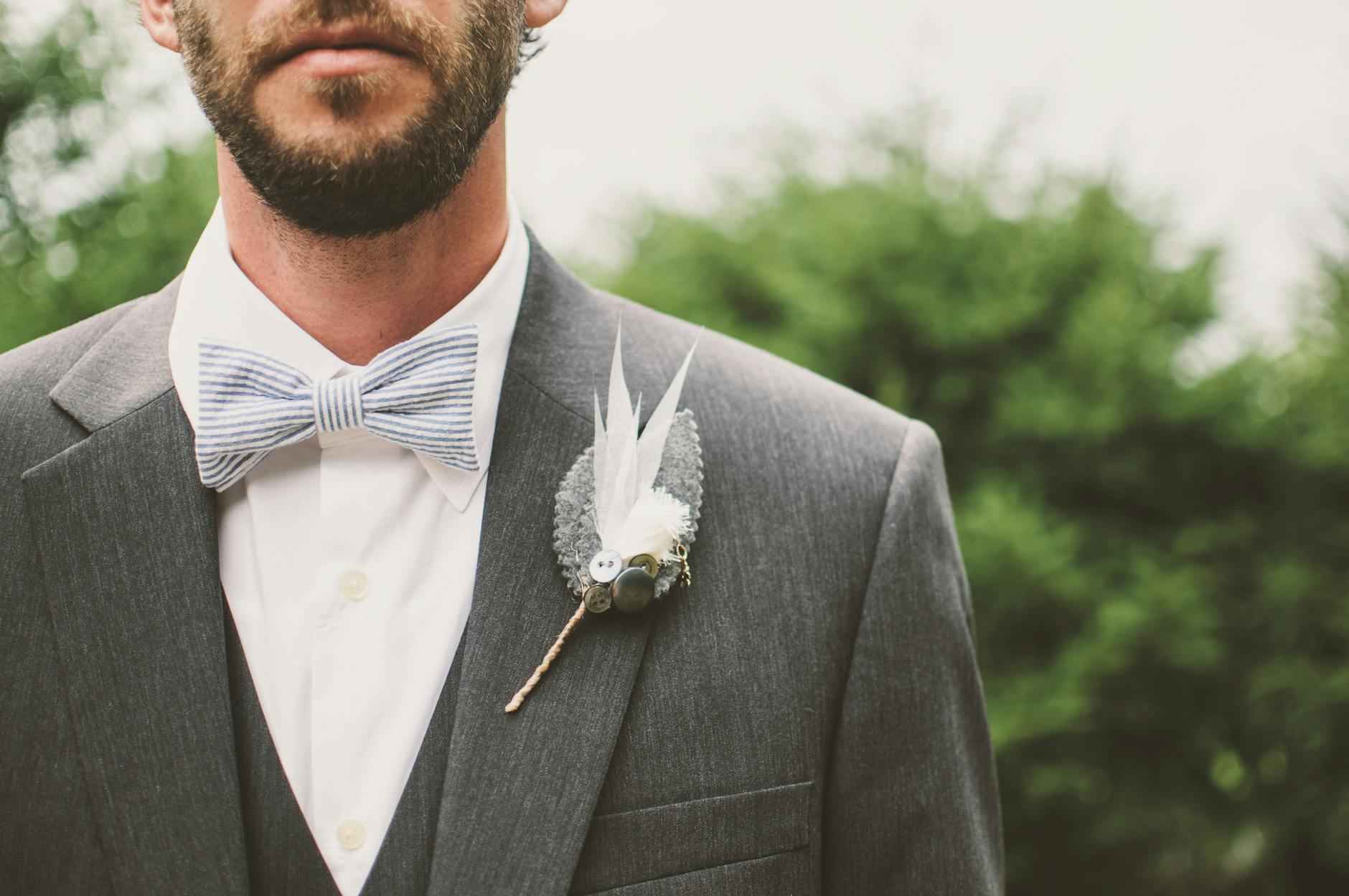
Step-by-Step Guide to Pinning a Boutonniere
Pinning a boutonniere may seem like a simple task, but doing it correctly ensures that you look polished and put-together for any formal occasion. Whether you’re attending a wedding, prom, or any other special event, mastering this skill is essential. This guide will walk you through the process step-by-step, ensuring you can pin your boutonniere in under 60 seconds.
- Step 1: Gather Your Materials
- A fresh boutonniere
- A sturdy pin or safety pin
- A mirror (optional, but helpful)
- Step 2: Prepare the Boutonniere
- Step 3: Choose the Right Placement
- Step 4: Pinning Technique
- Hold the boutonniere against the lapel where you want it to be placed.
- Take your pin and insert it from behind the lapel, going through the fabric and into the stem of the flower.
- Push the pin back out through the fabric, ensuring it is secure but not overly tight to avoid damaging the fabric.
- For added security, you may use a safety pin to hold the boutonniere in place, especially if it is a heavier flower.
- Step 5: Check for Stability
- Step 6: Final Touches
Before you begin, make sure you have the following items:
Ensure that the boutonniere is fresh and properly prepared. You might want to trim the stem to about 1-2 inches for a neat look. If you are using floral tape, wrap it around the stem to secure the flower and prevent any damage during the pinning process.
The ideal position for a boutonniere is on the left lapel of your jacket, just above the heart. This placement not only looks aesthetically pleasing but also symbolizes the emotional connection of the occasion.
To pin the boutonniere, follow these steps carefully:
After pinning, gently tug on the boutonniere to ensure it is secure. If it feels loose, adjust the pin or add a safety pin for extra support. Take a moment to check in the mirror to make sure it looks good from all angles.
Once you are confident that the boutonniere is securely pinned, give it a final look. Make sure it is not drooping or tilted. Adjust if necessary to achieve the desired look.
By following these steps, you can successfully pin a boutonniere in under 60 seconds. This skill not only enhances your appearance but also reflects your attention to detail, which is crucial for any formal event.
Remember, practice makes perfect! The more you pin, the easier it becomes. Soon, you’ll be able to do it quickly and confidently, ensuring that your boutonniere is always a stunning addition to your outfit.
Positioning the Boutonniere
When it comes to formal attire, a boutonniere is a small yet significant accessory that adds a touch of elegance and sophistication. However, the placement of the boutonniere is crucial to achieving a polished look. This article will delve into the best practices for positioning a boutonniere effectively, ensuring that it enhances your overall appearance.
Deciding where to place the boutonniere is essential. It should be positioned on the left lapel, ideally above the heart. This placement not only symbolizes love and affection but also provides a visually appealing focal point on your suit or tuxedo.
- Why the Left Side?
The left side is traditionally chosen for a boutonniere because it is closest to the heart, symbolizing the emotional significance of the flower. This placement is particularly important for events like weddings, where the boutonniere represents love and commitment.
- Height Matters
Position the boutonniere slightly above the pocket of your jacket. This height ensures that it is visible without overwhelming the overall look. A good rule of thumb is to place the flower around 4 to 6 inches above the pocket, which allows it to stand out while maintaining balance.
- Angle and Orientation
The boutonniere should be angled slightly upwards, which helps it catch the light and draw attention. A flower that is positioned flat against the lapel may appear lifeless and uninviting. Ensure that the bloom is facing outward, allowing it to be appreciated from different angles.
While the traditional placement is on the left lapel, there are various factors that can influence how you position your boutonniere:
| Factor | Consideration |
|---|---|
| Jacket Style | Different jacket styles may affect how the boutonniere sits. For instance, a shawl lapel may require slight adjustments in placement compared to a notch lapel. |
| Flower Type | Heavier flowers may need more support and should be positioned securely to prevent drooping. Lighter flowers can be placed more freely. |
| Body Type | Individuals with broader shoulders may want to adjust the placement slightly higher to maintain visual balance. |
Before the event, it’s wise to test the placement of the boutonniere. Here are some tips:
- Use a Mirror: Stand in front of a mirror while trying on your jacket with the boutonniere pinned. This will help you visualize how it looks from different angles.
- Ask for Feedback: Sometimes, a second opinion can provide valuable insights. Ask a friend or family member to assess the placement.
- Adjust as Needed: Don’t hesitate to make adjustments if the boutonniere doesn’t sit right. Comfort and confidence are key to carrying off any look.
In conclusion, the proper positioning of a boutonniere is vital for achieving a sophisticated and polished appearance. By placing it on the left lapel, above the heart, and considering factors such as jacket style and flower type, you can ensure that your boutonniere makes a statement. With these tips, you’ll be able to wear your boutonniere with pride, enhancing your overall look for any formal occasion.
Pinning Technique
When it comes to wearing a boutonniere, mastering the art of pinning is essential for achieving a polished and elegant look. The technique not only ensures that the flower stays securely in place throughout your event, but it also prevents any damage to your clothing. Here, we will delve into the detailed steps and considerations involved in the pinning process, ensuring that you can confidently adorn your lapel with a beautiful flower.
Step 1: Gather Your Materials
- Boutonniere: Choose a fresh flower that complements your outfit.
- Pin: A sturdy, sharp pin is essential for effective pinning.
- Floral Tape: Optional, but helpful for securing the stem.
- Scissors: For trimming the stem if necessary.
Step 2: Prepare the Boutonniere
Before you begin pinning, ensure the boutonniere is prepared properly. Trim the stem at an angle for better water absorption and a polished look. If using floral tape, wrap the stem securely to prevent any damage during the pinning process.
Step 3: Positioning the Boutonniere
Deciding where to place the boutonniere is crucial. The ideal position is on the left lapel, slightly above the heart. This location not only enhances visibility but also aligns with traditional etiquette. Make sure to hold the boutonniere in place to visualize how it will look once pinned.
Step 4: The Pinning Process
Now comes the actual pinning technique, which is key to a secure hold:
- Start by inserting the pin from behind the lapel. This method helps to hide the pin for a more polished appearance.
- Next, carefully push the pin through the stem of the flower. Ensure that the pin goes through the thicker part of the stem for better support.
- Finally, pull the pin back out through the fabric of your clothing. This should create a secure hold, anchoring the boutonniere in place.
Step 5: Check for Security
After pinning, gently tug on the boutonniere to ensure it is secure. If it shifts or feels loose, you may need to re-pin it. It’s essential to ensure that the flower sits comfortably against your lapel without any risk of falling off during the event.
Common Mistakes to Avoid
- Incorrect Placement: Avoid placing the boutonniere too low or too high, as this can detract from your overall look.
- Neglecting to Secure Properly: Failing to pin securely can lead to the boutonniere falling off, so always double-check your work.
- Using the Wrong Pin: Ensure that the pin is sturdy enough to hold the flower without damaging the fabric of your clothing.
Final Tips for a Successful Pinning Experience
Practice makes perfect. If you’re unsure, consider practicing the pinning technique on a piece of fabric before the big day. Additionally, if you’re wearing a heavier flower, consider using a safety pin for added security. This can help to ensure that your boutonniere stays in place, especially during outdoor events where movement is more pronounced.
By following these steps and tips, you can achieve a flawless boutonniere presentation that enhances your overall look. With a little practice and attention to detail, pinning a boutonniere can become a quick and easy task, allowing you to focus on enjoying your event.
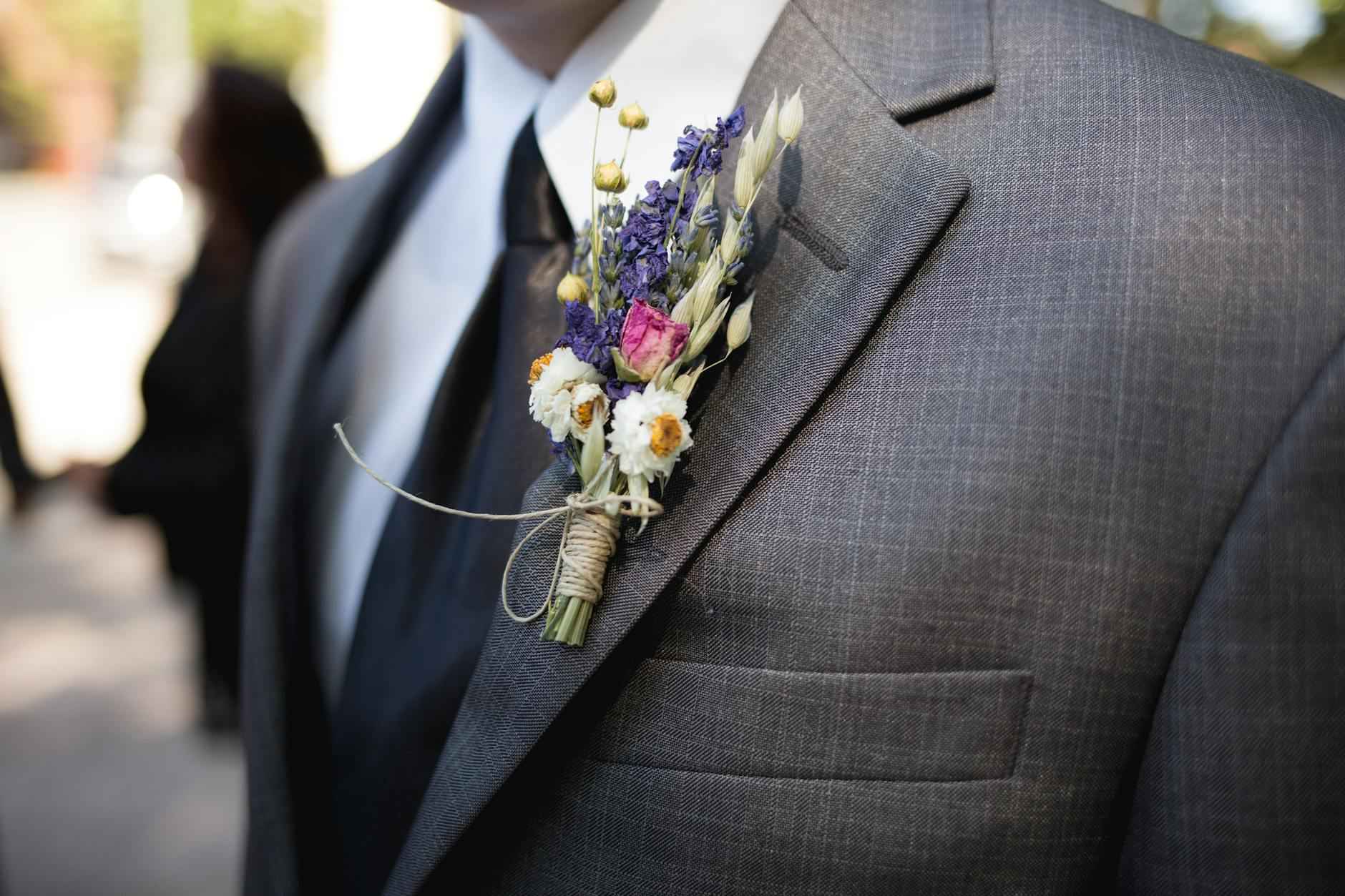
Common Mistakes to Avoid
Pinning a boutonniere might seem like a simple task, but there are several common mistakes that can lead to an unflattering presentation or even the boutonniere falling off entirely. By understanding these pitfalls, you can ensure a flawless display of this elegant accessory. Below are some key mistakes to avoid, along with practical tips to enhance your boutonniere experience.
- Poor Placement
- Neglecting to Secure Properly
- Choosing the Wrong Flower
- Ignoring Seasonal Availability
- Forgetting About Hydration
- Not Considering the Outfit
- Neglecting to Prepare the Stem
One of the most significant errors is improper placement of the boutonniere. It should be positioned on the left lapel, ideally above the heart. Placing it too low can make it less visible, while positioning it too high can create an awkward look. To find the perfect spot, look in the mirror and adjust as necessary.
Another common mistake is failing to pin the boutonniere securely. A loose pin can cause the flower to shift or fall off, leading to an embarrassing moment during an event. Always ensure that the pin goes through both the fabric of the lapel and the stem of the flower for a secure hold. Consider using a safety pin as a backup for added security.
Not all flowers are suitable for a boutonniere. Some may be too heavy, while others might wilt quickly. It’s important to choose a flower that is both aesthetically pleasing and durable. For instance, flowers like roses, orchids, and small daisies are popular choices due to their sturdiness and ability to hold up throughout an event.
Choosing flowers that are out of season can lead to higher costs and lower quality. Always check what flowers are in season to ensure you get the best options available. This not only helps with budget management but also enhances the overall look of your boutonniere.
Flowers need water to stay fresh. Failing to hydrate your boutonniere before pinning it can lead to wilting during the event. Keep the flower in water until just before the ceremony or event to maintain its vitality. If possible, mist the flower lightly with water before pinning.
The boutonniere should complement the outfit, not clash with it. Pay attention to the color scheme and style of the clothing. For example, a bright colored flower may stand out beautifully against a dark suit but could clash with a patterned shirt. Always consider the overall look when selecting a flower.
The preparation of the boutonniere’s stem is crucial for both aesthetics and functionality. A clean, angled cut allows for better water absorption, while wrapping the stem with floral tape can prevent damage during the pinning process. Always take the time to prepare the stem properly to enhance the overall presentation.
By avoiding these common mistakes, you can ensure that your boutonniere looks its best throughout the event. Remember, attention to detail is key when it comes to this small but significant accessory. With a little care and consideration, your boutonniere can be a stunning addition to your outfit, symbolizing elegance and style.
Poor Placement
When it comes to wearing a boutonniere, placement is key. The way you position this small but significant floral accessory can greatly influence your overall appearance. A boutonniere that is placed too low or too high can disrupt the visual balance of your outfit. This section will delve into the nuances of boutonniere placement and provide practical tips to ensure you achieve that ideal look.
The traditional and most recommended position for a boutonniere is on the left lapel, just above the heart. This location not only symbolizes love and affection but also allows the flower to be prominently displayed without overwhelming the rest of your attire. The ideal height for placement is approximately 4 to 6 inches above the bottom of the lapel. This positioning ensures that the boutonniere is visible while maintaining a sense of elegance.
Proper placement is essential for several reasons:
- Visual Balance: A boutonniere that is too low can make the outfit appear unbalanced, while one that is too high may look awkward. Finding the middle ground is crucial for a polished look.
- Accessibility: The boutonniere should be easily visible for photographs and interactions, which is why the left lapel is the preferred spot.
- Symbolism: The placement above the heart carries a deeper meaning, often associated with love and respect, especially during formal occasions like weddings.
To ensure that your boutonniere is placed correctly, follow these simple steps:
- Stand in Front of a Mirror: Before pinning your boutonniere, stand in front of a mirror to visualize where it will go. This helps you gauge the best height and angle.
- Use a Measuring Tool: If you want to be precise, use a measuring tape or a ruler to measure about 4 to 6 inches from the bottom of the lapel. Mark this spot lightly with a pencil if necessary.
- Pin Securely: When you pin the boutonniere, insert the pin from the back of the lapel to ensure it holds securely without being visible. This technique will keep your boutonniere in place throughout the event.
Here are some common pitfalls to watch out for when placing your boutonniere:
- Too Low: If the boutonniere is positioned too low, it can look like an afterthought rather than a statement piece. This can detract from the overall aesthetic of your outfit.
- Too High: Conversely, a boutonniere that is placed too high can appear awkward and may not sit well against the fabric of your lapel.
- Ignoring Fabric Type: Different fabrics react differently to pins. Ensure that you choose a pin that is appropriate for the thickness and type of your lapel fabric to avoid any damage.
Once your boutonniere is pinned in the ideal position, maintaining its look throughout the event is equally important. Here are some tips:
- Check the placement periodically to ensure it hasn’t shifted.- Avoid leaning against surfaces that might crush the flower.- If possible, keep the boutonniere hydrated until just before the event to maintain its freshness.
In conclusion, proper placement of a boutonniere is critical for achieving a polished and elegant appearance. By understanding the importance of positioning, following the right steps, and avoiding common mistakes, you can ensure that your boutonniere enhances your outfit rather than detracts from it. Remember, the goal is to create a cohesive and stylish look that reflects your personal style while honoring the significance of this elegant accessory.
Neglecting to Secure Properly
When it comes to wearing a boutonniere, the way it is pinned can greatly affect its appearance and longevity throughout an event. One of the most critical aspects of pinning a boutonniere is ensuring it is secured properly. can lead to unfortunate mishaps, such as the boutonniere falling off or shifting during wear. This not only detracts from your overall look but can also be quite embarrassing during formal occasions. In this section, we will delve into the reasons why proper securing is essential and provide tips on how to achieve the best results.
Securing a boutonniere correctly is crucial for several reasons:
- Visual Appeal: A well-secured boutonniere maintains its intended position, contributing to a polished and sophisticated appearance.
- Comfort: A boutonniere that is not pinned securely can shift or poke at the wearer, leading to discomfort over time.
- Longevity: Properly securing the boutonniere helps it withstand movement and environmental factors, ensuring it remains fresh for the duration of the event.
When a boutonniere is not pinned securely, several issues can arise:
- Falling Off: A boutonniere that is loosely pinned can easily detach, especially during hugs or movement, leading to a loss of the accessory.
- Shifting Position: If the boutonniere is not anchored properly, it may move out of its ideal position, which can disrupt the overall aesthetic.
- Damage to Clothing: An improperly secured boutonniere may cause fabric pulls or tears, especially if a sharp pin is used incorrectly.
To avoid the pitfalls of improper securing, consider the following techniques:
1. Choose the Right Pin: Use a sturdy, sharp pin that can penetrate both the fabric and the stem of the flower without causing damage.2. Pin from Behind: Insert the pin from behind the lapel to ensure it is hidden from view and provides a clean look.3. Angle the Pin: Angle the pin through the stem of the flower and back out through the fabric. This helps create a secure hold.4. Double Pinning: For added security, consider using two pins. This is especially useful for heavier flowers or during outdoor events where movement is expected.
Here are additional tips to help ensure your boutonniere is pinned securely:
- Test the Stability: After pinning, gently tug on the boutonniere to make sure it feels secure.
- Monitor Throughout the Event: Check periodically to ensure the boutonniere hasn’t shifted, especially after dancing or moving around.
- Practice Beforehand: If you’re unsure about the pinning process, practice beforehand to build confidence and ensure you get it right on the day of the event.
In summary, neglecting to secure a boutonniere properly can lead to a range of issues that detract from your overall appearance and comfort. By understanding the importance of proper pinning techniques and following the outlined tips, you can ensure that your boutonniere remains securely in place, allowing you to enjoy your event without worry. With practice and attention to detail, you can master the art of pinning a boutonniere, enhancing your formal attire and showcasing your style.
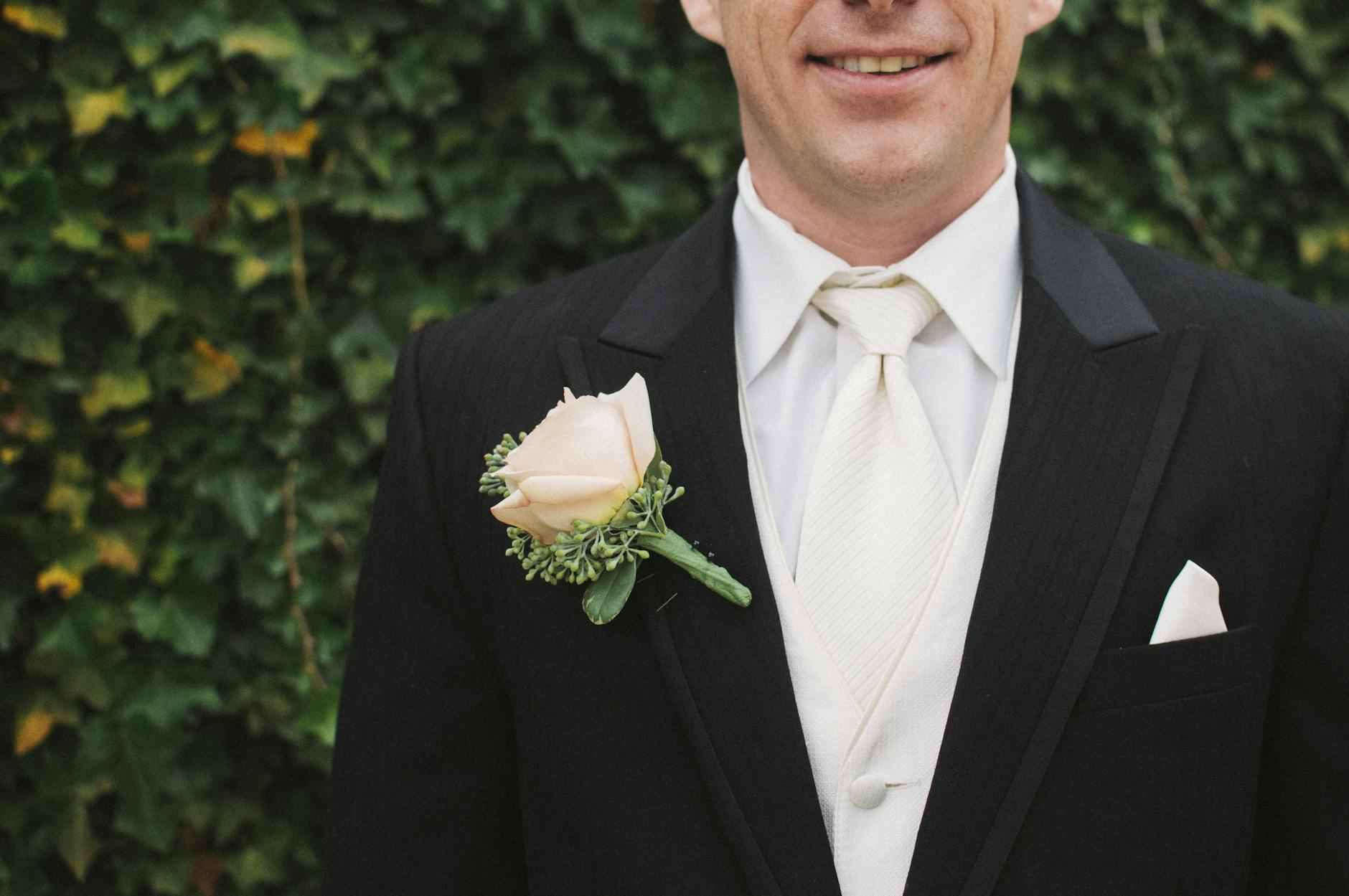
Maintaining Your Boutonniere Throughout the Event
When it comes to formal events, a boutonniere is not just an accessory; it is a statement of style and elegance. However, to ensure that your boutonniere remains fresh and visually appealing throughout the event, proper maintenance is crucial. Here are some essential tips to keep your boutonniere looking its best.
Maintaining your boutonniere is vital for several reasons:
- Aesthetic Appeal: A fresh boutonniere enhances your overall appearance and complements your outfit.
- Symbol of Care: A well-kept boutonniere reflects your attention to detail and respect for the occasion.
- Longevity: Proper care can prolong the life of the flower, allowing you to enjoy its beauty for longer.
Hydration is key to maintaining the freshness of your boutonniere. Here are some practical tips:
- Pre-Event Hydration: If possible, keep the boutonniere in a small container of water until just before the event. This will help the flower absorb moisture and stay vibrant.
- Watering Techniques: If your boutonniere has a longer stem, you might want to place it in a shallow vase or jar filled with water. Ensure that the water level is just enough to cover the stem without submerging the petals.
- Moisture Spritz: A light mist of water can help keep the petals from wilting. However, be cautious not to overdo it, as too much moisture can lead to drooping.
Heat and sunlight can quickly wilt a boutonniere, making it essential to keep it in a cool environment. Consider the following:
- Indoor vs. Outdoor Events: If you are attending an outdoor event, try to stay in shaded areas as much as possible. Direct sunlight can cause the petals to dry out and lose their vibrant colors.
- Temperature Control: If you are indoors, ensure that the venue is not overly warm. Avoid placing your boutonniere near heat sources such as radiators or fireplaces.
How you handle your boutonniere can make a significant difference in its appearance. Here are some tips:
- Gentle Touch: Always handle your boutonniere with care. Avoid squeezing or pressing on the petals, as this can bruise them and lead to premature wilting.
- Secure Pinning: Ensure that your boutonniere is securely pinned to your clothing. A loose boutonniere can shift and become damaged throughout the event.
Even with the best care, sometimes a boutonniere may start to wilt. Here’s how to address the situation:
- Quick Refresh: If you notice that your boutonniere is wilting, you can try to give it a quick refresh by placing it in water for a few minutes.
- Remove Damaged Petals: If some petals are beyond saving, carefully remove them to improve the overall appearance of the boutonniere.
Just before the event, take a moment to check your boutonniere:
- Final Inspection: Look for any wilted petals or damage that may need to be addressed.
- Adjusting Position: Ensure that the boutonniere is positioned correctly on your lapel for maximum impact.
By following these maintenance tips, you can ensure that your boutonniere remains fresh and beautiful throughout the event, allowing you to make a lasting impression.
Staying Hydrated
Maintaining the freshness of a boutonniere is crucial for ensuring it looks its best throughout an event. One of the most effective ways to achieve this is by keeping the boutonniere hydrated. This simple yet essential step can significantly enhance the longevity and appearance of the flower. Here’s a comprehensive guide on how to effectively manage hydration for your boutonniere.
- Understanding the Need for Hydration: Fresh flowers are living organisms that require water to stay vibrant. Without adequate hydration, a boutonniere can wilt, lose its color, and ultimately detract from your overall appearance.
- Timing is Key: It’s best to keep the boutonniere in water until just before the event. This practice ensures that the flower retains moisture and freshness, making it visually appealing.
- Water Sources: If possible, place the boutonniere in a small container filled with water. Ensure that only the stem is submerged, as too much water can damage the petals.
Before the event, take the time to prepare the boutonniere properly. Here are some tips for optimal hydration:
- Trim the Stem: Make a clean, angled cut at the bottom of the stem just before placing it in water. This technique allows for better water absorption.
- Use a Floral Preservative: If available, mix floral preservatives in the water. These solutions contain nutrients that can help prolong the life of the flower.
- Monitor Water Levels: Check the water level regularly to ensure that the stem remains submerged. Replace the water if it becomes cloudy or if the level drops significantly.
In addition to keeping the boutonniere hydrated, it’s essential to consider the environment in which it is kept:
| Environment Factors | Impact on Hydration | Recommended Actions |
|---|---|---|
| Heat | Accelerates wilting and drying out of the flower. | Keep the boutonniere in a cool place, away from direct sunlight and heat sources. |
| Humidity | Can help maintain moisture levels but too much can lead to mold. | Store in a moderately humid environment, avoiding overly damp areas. |
| Airflow | Good airflow can help prevent mold but excessive airflow can dry out the flower. | Ensure a balance of airflow without direct drafts. |
As the event approaches, remove the boutonniere from water just before pinning it on. This brief period outside of water will not harm the flower, especially if it has been well-hydrated beforehand. When pinning, handle the boutonniere gently to avoid bruising the petals. A well-hydrated boutonniere will not only look stunning but will also stay in place throughout the day.
Finally, remember that the care you provide to your boutonniere reflects your attention to detail and enhances your overall presentation at any formal event. By following these hydration tips, you can ensure that your boutonniere remains fresh, vibrant, and a beautiful accessory to your attire.
Avoiding Heat and Direct Sunlight
When it comes to maintaining the appearance of a boutonniere, one of the most critical factors is protecting it from heat sources and direct sunlight. These elements can significantly affect the longevity and freshness of the flowers, leading to wilting and discoloration. Here, we explore why this is essential and how you can effectively keep your boutonniere looking its best throughout your event.
First, let’s understand the impact of heat on flowers. Heat can cause the flowers to lose moisture rapidly, leading to a dry and shriveled appearance. This is particularly true for delicate varieties like orchids and lilies, which are more sensitive to temperature changes. Flowers are living organisms that continue to react to their environment even after being cut. Thus, exposure to high temperatures can accelerate their deterioration.
In addition to heat, direct sunlight poses a significant threat to the vibrancy of your boutonniere. Sunlight can bleach colors and cause petals to become crispy and brown at the edges. To illustrate this point, consider the following table:
| Factor | Impact on Boutonniere |
|---|---|
| Heat | Causes moisture loss, leading to wilting and drooping. |
| Direct Sunlight | Bleaches colors and damages petals, affecting overall appearance. |
To preserve the freshness of your boutonniere, it is advisable to take specific preventive measures. Here are some practical tips:
- Store in a Cool Place: Before the event, keep your boutonniere in a refrigerator or a cool, shaded area. This will help maintain its moisture levels and prevent wilting.
- Avoid Hot Environments: If you are attending an outdoor event, try to stay in shaded areas as much as possible. Avoid areas near heaters, grills, or other heat sources.
- Limit Exposure: If you need to wear your boutonniere for an extended period, consider taking it off during breaks or when you’re not in front of guests to reduce exposure to heat and sunlight.
- Use Water Sources: If possible, keep the boutonniere in a small container of water until you are ready to pin it on. This will help keep the flowers hydrated.
In addition to the above tips, be mindful of how you handle your boutonniere. When pinning it to your lapel, do so quickly and efficiently to minimize its exposure to heat from your body. Also, avoid touching the flowers excessively, as oils from your hands can contribute to their decline.
Finally, it’s essential to be aware of the type of flowers you choose for your boutonniere. Some flowers are more resilient to heat and sunlight than others. For instance, carnations and chrysanthemums tend to hold up better in warmer conditions compared to more delicate options. Understanding the characteristics of your chosen flower can aid in making informed decisions that will keep your boutonniere looking stunning.
In summary, avoiding heat and direct sunlight is crucial for maintaining the beauty of your boutonniere. By taking the necessary precautions and being mindful of your environment, you can ensure that your boutonniere remains a symbol of elegance and style throughout your event.
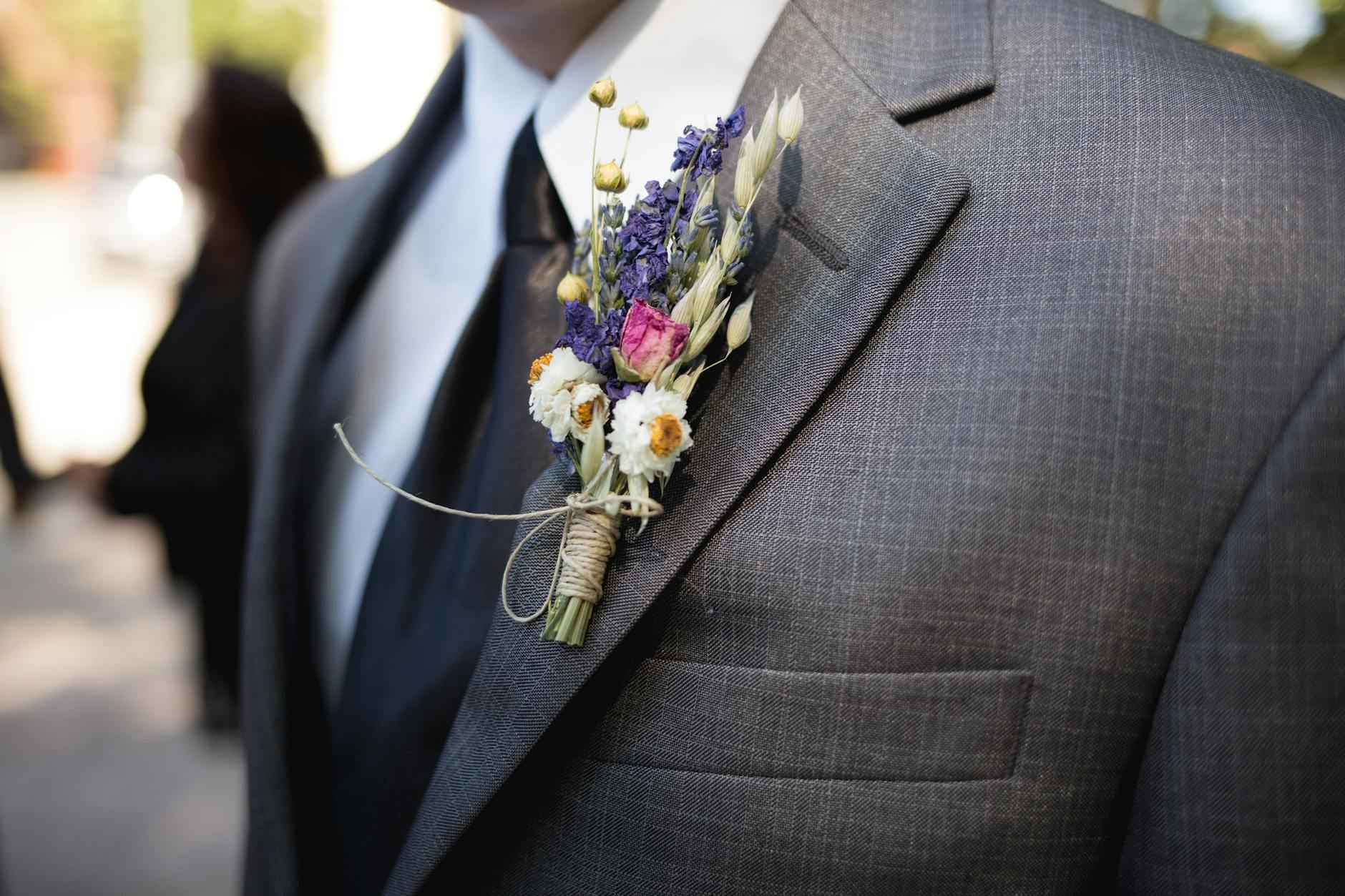
Removing the Boutonniere Gracefully
When it comes to wearing a boutonniere, the focus is often on the beauty and elegance it brings to an outfit. However, knowing how to remove the boutonniere without causing damage is equally important. This section delves into the best practices for removing a boutonniere gracefully, ensuring both the flower and your clothing remain unharmed.
Removing a boutonniere might seem like a simple task, but it requires careful attention to avoid any mishaps. The boutonniere is typically pinned onto delicate fabrics, and improper removal can lead to snags, tears, or even damage to the flower itself. By following the right techniques, you can ensure a smooth removal process.
- Assess the Situation: Before you begin, take a moment to assess how the boutonniere is pinned. Understanding the pin’s placement can help you plan your removal strategy.
- Locate the Pin: Gently lift the flower to identify where the pin is inserted. This will often be through the flower stem and into the fabric of your lapel.
- Use Gentle Pressure: Apply light pressure to the fabric around the pin. This helps to create some slack, making it easier to pull the pin out without tugging on the fabric.
- Remove the Pin: Grasp the pin firmly but gently and pull it out in the opposite direction of how it was inserted. Avoid yanking or pulling too hard, as this can damage both the flower and your clothing.
- Inspect for Damage: After the pin is removed, check your clothing for any potential snags or tears. If there are any issues, address them immediately to prevent further damage.
To ensure a flawless removal process, consider these additional tips:
- Wear the Right Clothing: If possible, choose fabrics that are more resilient to pinning, such as wool or thicker cotton. These materials are less likely to sustain damage compared to delicate fabrics like silk.
- Be Mindful of the Flower: If the boutonniere is particularly fragile, such as those made from delicate blooms like peonies or gardenias, handle it with extra care during removal.
- Consider Using a Safety Pin: For added security during wear, consider using a safety pin in addition to the regular pin. This can help to distribute the weight of the boutonniere more evenly and reduce the risk of it falling off.
If you wish to keep the boutonniere after the event, proper storage is essential to preserve its beauty. Here are some steps to consider:
- Cool Storage: Place the boutonniere in a cool, dark place. Avoid direct sunlight and heat sources, which can cause the flowers to wilt.
- Use a Container: If possible, store the boutonniere in a small container with a damp paper towel to keep it hydrated. This can help maintain its freshness for a longer period.
- Consider Pressing: If you want to preserve the boutonniere as a keepsake, consider pressing the flowers between the pages of a heavy book. This can create a beautiful memento from the occasion.
Removing a boutonniere gracefully is a skill that can enhance your overall experience at any formal event. By following the steps outlined above and taking the necessary precautions, you can ensure that both your clothing and the boutonniere remain in excellent condition. Remember, a little care goes a long way in preserving the elegance of this small but significant accessory.
Careful Removal Techniques
When it comes to wearing a boutonniere, the process of attaching it is only half the battle; knowing how to remove it gracefully is equally important. A boutonniere, while a beautiful accessory, can be delicate and may cause damage to your clothing if not removed properly. This guide will provide you with essential techniques to ensure that you can remove your boutonniere without causing any harm to your attire.
To begin with, it’s crucial to understand the anatomy of the boutonniere and the pinning method used. Typically, a boutonniere is attached using a pin that goes through the flower stem and into the fabric of your lapel. This method secures the flower in place but can also lead to potential snags or tears if not handled correctly.
- Assess the Situation: Before attempting to remove the boutonniere, take a moment to assess how it is pinned. Look for the pin’s entry and exit points to understand where you need to apply pressure.
- Gather Your Tools: While you may not need any specialized tools for removal, having a pair of scissors or a safety pin nearby can be helpful in case the pin gets stuck.
Now, let’s delve into the step-by-step process of removing the boutonniere:
- Locate the Pin: Identify the pin that holds the boutonniere in place. This is typically visible at the back of the flower or through the fabric of your clothing.
- Apply Gentle Pressure: Using your fingers, gently grasp the flower and the fabric surrounding the pin. It’s essential to apply gentle pressure to avoid tearing the fabric. You want to create a slight tension that allows you to pull the pin out without causing any damage.
- Pin Removal: With your other hand, carefully grasp the pin and pull it out in the direction it was inserted. If you encounter resistance, stop and reassess. Never yank the pin out, as this can lead to fabric tears.
- Check for Residue: After removing the pin, check both the boutonniere and your clothing for any residual bits of stem or floral tape. These should be removed gently to avoid any further damage.
Here are some additional tips to keep in mind:
- Timing: Remove the boutonniere as soon as the event is over. The longer it stays pinned, the more likely it is to cause wear on the fabric.
- Storage: If you wish to keep the boutonniere, store it in a cool, dry place. This will help maintain its shape and prevent wilting.
It’s also worth noting that the type of fabric plays a significant role in how you should approach the removal process. For instance, delicate materials like silk or satin require extra caution, while sturdier fabrics like cotton may be more forgiving. Always tailor your approach based on the fabric type to minimize the risk of damage.
In conclusion, mastering the art of boutonniere removal is just as important as the initial pinning process. By following these careful removal techniques, you can ensure a seamless experience that maintains the integrity of your clothing while preserving the beauty of your boutonniere. Remember, the key is to be gentle and patient, allowing you to enjoy your formal occasion without the worry of damaging your outfit.
Storing the Boutonniere
When it comes to preserving the beauty of a boutonniere, proper storage is essential. This small yet significant floral accessory can carry sentimental value and aesthetic appeal, especially if it was worn during a memorable occasion such as a wedding or prom. To ensure that your boutonniere remains vibrant and intact for as long as possible, follow these key storage tips.
- Choose the Right Environment: The location where you store your boutonniere plays a critical role in its longevity. Ideally, you should keep it in a cool, dry place away from direct sunlight and heat sources. Excessive warmth can cause the flowers to wilt and lose their freshness.
- Use a Humidifier or Water: If possible, place the boutonniere in a small container with a bit of water to keep it hydrated. Alternatively, you can lightly mist the flowers with water before storing them. This will help maintain their moisture levels.
- Avoid Crushing: Ensure that the boutonniere is stored in a way that prevents it from being crushed or squished. You can use a small box or a dedicated floral storage container to give it the necessary space.
For those who wish to preserve their boutonniere even longer, consider these advanced storage techniques:
| Method | Description | Pros | Cons |
|---|---|---|---|
| Drying | Hang the boutonniere upside down in a cool, dark place until completely dry. | Long-lasting, retains shape. | May lose color and vibrancy. |
| Pressing | Place the boutonniere between two sheets of parchment paper and press it under heavy books. | Creates a beautiful keepsake. | Not suitable for all flowers. |
| Framing | After drying or pressing, frame the boutonniere for display. | Offers a decorative way to preserve memories. | Requires additional materials. |
For those who choose to keep their boutonniere in its original form, here are some additional tips:
1. Wrap the stem with a damp paper towel.2. Place the wrapped stem in a plastic bag to maintain moisture.3. Store the bag in the refrigerator, ensuring it is upright to avoid damage.
These methods not only help in preserving the boutonniere’s appearance but also allow you to cherish the memories associated with it. Remember, the key to a successful storage method is prevention—preventing wilting, crushing, and exposure to harsh conditions. By following these guidelines, you can keep your boutonniere looking fresh and beautiful for as long as possible.
In conclusion, whether you plan to keep your boutonniere as a memento or simply want to ensure it looks its best throughout an event, proper storage is vital. Taking the time to store it correctly will allow you to enjoy its beauty and significance long after the occasion has passed.
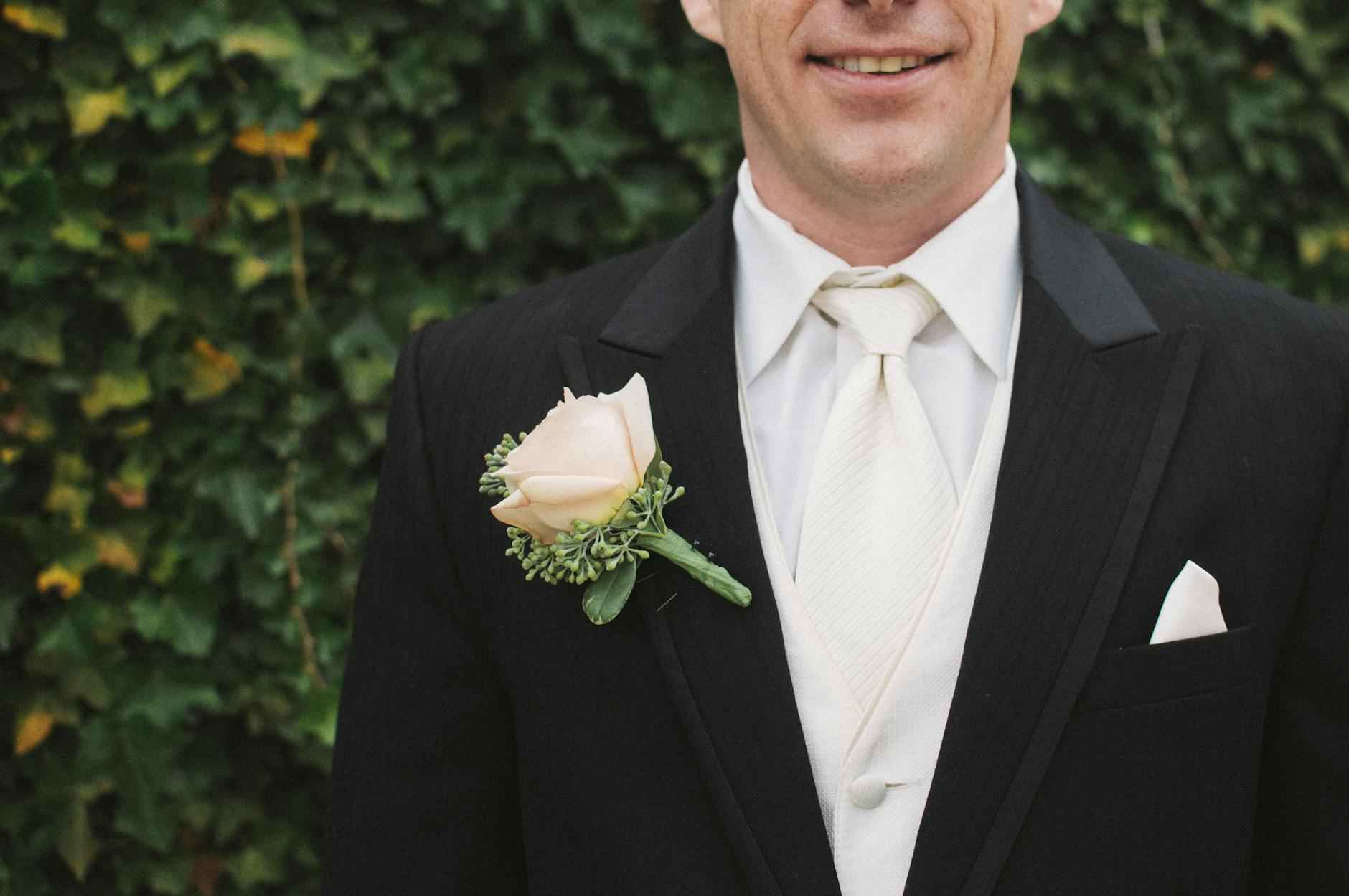
Conclusion: Mastering the Art of Pinning a Boutonniere
Mastering the Art of Pinning a Boutonniere is an essential skill that can elevate your style and presentation at any formal event. A boutonniere, typically a single flower or a small cluster of flowers, is worn on the lapel of a suit jacket or tuxedo. It serves as a symbol of elegance and sophistication, and knowing how to pin it correctly can make a significant difference in your overall appearance. With practice and attention to detail, anyone can become proficient in this art in under 60 seconds.
Understanding the importance of properly pinning a boutonniere is crucial. A well-pinned boutonniere not only enhances your look but also demonstrates attention to detail and style. Improperly pinned flowers can droop, fall off, or even damage your clothing. Therefore, mastering this skill is essential for anyone looking to make a lasting impression.
Before you start pinning, gather the necessary tools to streamline the process:
- Pin: A sturdy, sharp pin is essential for securing the boutonniere without damaging the fabric.
- Floral Tape: This helps to secure the flower and can prevent damage during pinning.
- Scissors: For trimming the stem to the right length.
- Mirror: To ensure proper placement and alignment.
Preparation is key to a successful pinning. Here are the steps to follow:
- Trim the Stem: Use scissors to make a clean, angled cut on the stem. This not only helps with water absorption but also gives the boutonniere a polished look.
- Wrap with Floral Tape: Secure the stem with floral tape to hold the flower in place and prevent any damage during the pinning process.
Now that you have prepared your boutonniere, follow these simple steps to pin it:
- Position the Flower: The boutonniere should be placed on the left lapel, ideally above the heart. This positioning is traditional and visually appealing.
- Insert the Pin: Start from behind the lapel, insert the pin through the stem of the flower, and then push it back out through the fabric. Ensure it is secure but not too tight to avoid damaging the fabric.
Being aware of common pitfalls can help you achieve a flawless look:
- Poor Placement: Avoid placing the boutonniere too low or too high. The ideal position enhances your overall appearance.
- Neglecting Security: Failing to pin securely can lead to the boutonniere falling off or shifting. Always check the stability after pinning.
To keep your boutonniere looking fresh throughout the event, consider the following tips:
- Hydration: Keep the boutonniere in water until just before the event to preserve its freshness.
- Avoid Heat: Keep it away from heat sources and direct sunlight to maintain its appearance.
Knowing how to remove the boutonniere without causing damage is just as important as pinning it. Here’s how:
- Gentle Pressure: Use gentle pressure to remove the pin, ensuring you do not damage the fabric of your clothing.
- Storage: If you wish to keep the boutonniere, store it in a cool place to preserve its beauty for a longer time.
With these detailed steps and tips, you can confidently master the art of pinning a boutonniere in under 60 seconds. This skill not only enhances your appearance but also adds a touch of sophistication to any formal occasion.














